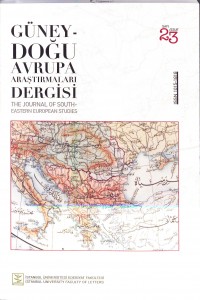Öz
In the 1840s - 1870s thc Ottoman reformers sought to actualize the Muslim education. Since they considered the Muslim primary education as an essential base of the training at the higher schools, my paper explored the available data about its network, the funding, the instruction and the enrolment rate of the pupils in North Dobruca. Despite the partial data about the urban mektebs, there was a certain development of the primary education in the towns. The interest ofthe pupils, girls and boys, towards the new-founded mektebs was due to the factors such as the adherence to the traditional values and social models and the opportunity of acquiring practical skills. The density of the village school network varied between 90-100%. The Muslims provided the construction costs by themselves, by minor loans from the capitals of the Public Benefits Bank, or by the sale of the ram furs. Thcy failed to establish school funds in order to secure the mektebs' daily expense and the teachers' wages. The promotion of the actualized curriculum was related to the teachers' qualification and the actual enrolment rate in North Dobruca. Except few cases, the enrolment rate varied between one third and two thirds.
Anahtar Kelimeler
Kaynakça
- Selim Sabit, Rehnüma-yi Muallimin. Sıbyan Mekteplerine Mahsus Usul-i Tedrisiyye, Istanbul Daru'l-Matbaat-i Amire s. a. Salname-i Devlet-i Aliye-i Osmaniye, Defa 2, lstanbul: Daru'l-Matbaat-i Amire 1264 ( 1848/1849). Salname-i Vilayet-i Tuna. Defa 2, 5-9, Rusçuk: Tuna Vilayeti Matbaası 1286 ( 1869), 1289-1293 ( 1872-1877).
Öz
Kaynakça
- Selim Sabit, Rehnüma-yi Muallimin. Sıbyan Mekteplerine Mahsus Usul-i Tedrisiyye, Istanbul Daru'l-Matbaat-i Amire s. a. Salname-i Devlet-i Aliye-i Osmaniye, Defa 2, lstanbul: Daru'l-Matbaat-i Amire 1264 ( 1848/1849). Salname-i Vilayet-i Tuna. Defa 2, 5-9, Rusçuk: Tuna Vilayeti Matbaası 1286 ( 1869), 1289-1293 ( 1872-1877).
Ayrıntılar
| Bölüm | Araştırma Makalesi |
|---|---|
| Yazarlar | |
| Yayımlanma Tarihi | 12 Aralık 2013 |
| Yayımlandığı Sayı | Yıl 2013 Sayı: 23 |


